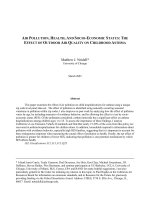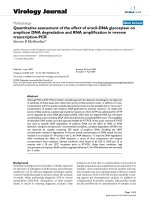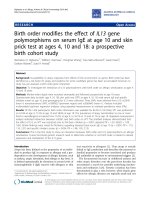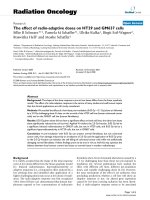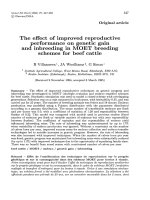Serene arts the effect of personal unsettledness and of paintings narrative structure on personality
Bạn đang xem bản rút gọn của tài liệu. Xem và tải ngay bản đầy đủ của tài liệu tại đây (102.42 KB, 11 trang )
EMPIRICAL STUDIES OF THE ARTS, Vol. 30(2) 183-193, 2012
SERENE ARTS: THE EFFECT OF PERSONAL
UNSETTLEDNESS AND OF PAINTINGS’
NARRATIVE STRUCTURE ON PERSONALITY
MAJA DJIKIC
KEITH OATLEY
JORDAN B. PETERSON
University of Toronto
ABSTRACT
Previous research has demonstrated that art can produce some variation
in self-reported personality traits. The present experiment addressed two
questions. First, does visual art cause greater fluctuations in personality for
unsettled or serene individuals, and second, do unsettled individuals respond
more to art as a function of its narrative structure? Participants (N = 61)
completed a set of questionnaires, then viewed a series of paintings, Giotto’s
Seven Vices, either unmodified to exhibit high narrative structure, or
modified to exhibit low narrative structure, and then filled another set of
questionnaires. The results show that unsettled individuals experienced
significantly less fluctuation of personality across conditions, and that in the
condition of low narrative coherence, serene individuals experienced
significantly more personality fluctuations than unsettled individuals. The
results suggest that unsettled persons may need more narrative coherence
in the art they engage with, while serene individuals may remain open to
less-structured and more ambiguous art.
Developmental psychologists have long known that periods of increased variability can precede developmental transitions, a process that has been found to be
relevant for changes in generally stable systems such as personality (Vallacher,
183
Ó 2012, Baywood Publishing Co., Inc.
doi: />
184 / DJIKIC, OATLEY AND PETERSON
Read, & Novak, 2002). According to research on dynamical systems theory, an
important factor in predicting whether a change in a stable system will happen is
a type of discontinuity in the system called “critical fluctuation” (Bak & Chen,
1991; Schiepek, Eckert, & Weihrauch, 2003; van der Maas & Molenaar, 1992),
which must be reached if the system is to be reorganized into a new configuration. Besides movements through developmental stages, perturbation can be
produced by traumas such as those that give rise to post-traumatic stress syndrome (Bonanno, 2004), by psychotherapeutic interventions (Hayes et al., 2007),
by dramatic life transitions sometimes called “adversarial growth” (Linley &
Joseph, 2004; Tedeschi & Calhoun, 2004), and by stressful life events (Oatley
& Djikic, 2002). Recent research shows that art can also produce increases
in the variability of personality traits (Djikic, Oatley, Zoeterman & Peterson,
2009a, 2009b; Djikic, 2011), and these results point toward a path by which
art might prompt personality changes.
This article addresses two related questions. The first is whether art is more
likely to cause fluctuations in unsettled individuals or in those who are more
serene. On one hand, individuals who suffer from “crystallization of discontent”
(Baumeister, 1994), and who find themselves in a state of distress and dissonance
that often precedes change, may be more fragile when exposed to other stimuli that
can produce further destabilization. However, it can also be argued that unlike
what happens in response to trauma or during genetically prompted developmental
growth, individuals usually choose to expose themselves to art voluntarily. If
we present people with pieces of art as experimental stimuli, individuals who
already feel unsettled may defensively maintain their representations of personality, while serene individuals may let themselves experience and represent
fluctuations of personality produced by art. The first hypothesis that will be tested
in this study is that when exposed to art, unsettled individuals will experience
significantly less personality variability than serene individuals.
The second issue we address in this paper is whether unsettled and serene
individuals show preferences for works of visual art in terms of levels of narrative
description that different kinds of picture invite. Disruptions due to personal
uncertainty can lead to compensatory conviction (McGregor, Zanna, Holmes, &
Spencer, 2001), while a threat to one’s sense of self may provoke “hardening
of categories” (Kelly, 1955), and “hardening of attitudes” (Altemeyer, 1994).
In such cases, a response to distress caused by an uncertainty may lead to a
need for structured ideas about who one is, about what one thinks about the
world and oneself (Peterson, 1999). The less narrative structure there is in a
picture, the more threatening it may become for unsettled individuals, who
may prefer more structure and try to stabilize their sense of self. The second
hypothesis, then, proposes that it is serene, rather than unsettled, individuals
who will experience more personality variability in response to works of visual
art with less narrative structure.
SERENE ARTS / 185
The works of visual art we chose for this study were Giotto’s (1267-1337)
cycle of Seven Vices, frescoes in the Arena Chapel in Padua, Italy. The
Vices, each represented as a single figure in a separate painting, are Desperation,
Envy, Infidelity, Injustice, Wrath, Inconstancy, and Foolishness. These paintings
are not portraits but pictures that invite viewers to observe them, and to tell
themselves a certain kind of narrative story about them. We think it is safe
to say that the intention of the painter was to induce in his viewers a repulsion
from each Vice he depicted, and a disposition to avoid succumbing to it.
An example is Envy, depicted as a woman standing within the plinth of a
building. She extends her right hand in the shape of a claw, while her left
hand grasps a bag of money. Coming from her mouth is a serpent that has
turned round and is about to bite her eye. The bottom of her long dress is
enveloped in flames. The narratives we might tell ourselves are not just about
each picture individually, but about the series. So, for instance, we might think
that whereas in the Vice of Envy we torment ourselves, in the Vice of Injustice
we torment others.
Although Giotto’s unmodified paintings are not realistic in the nineteenthcentury sense, they do present recognizable human figures, about whom viewers
can tell themselves narratives, of the kind described above. We have chosen to
think about the pictures we presented here in terms of the coherence of narratives they suggest, prompted by the titles of the pictures, “Desperation,” “Envy,”
and so on, because we want to relate our results to previous studies in which
we have measured personality change in response to manipulations of more
explicit forms of narrative in a short story (Djikic et al., 2009a, 2009b). Equally,
however, we could think of the manipulation we make here in terms of visual
art that is representational as compared with visual art that is less representational and more abstract.
To vary the level of narrative structure (the pictures’ representational quality),
we presented reproductions of Giotto’s paintings either unmodified, or modified
by exchanging their diagonally opposite quadrants. For instance, in the modified
version of Envy, the woman figure was no longer presented whole, but cut
into four pieces. The section that shows her claw-like hand and the serpent,
originally the top left quadrant, was moved to the bottom right quadrant, and its
place was taken by half of the depiction of the flames enveloping the bottom
right hand part of the figure’s long dress.
Our hypotheses were: (a) that serene individuals would experience more
personality fluctuation than unsettled individuals across the comparison between
unmodified and modified pictures, and (b) that participants’ level of unsettledness would interact with whether the pictures were unmodified or modified
such that the modified pictures (with less narrative structure and less of a representational quality) would prompt less fluctuation of personality in unsettled
than in serene individuals.
186 / DJIKIC, OATLEY AND PETERSON
METHOD
Participants
Sixty-one first year undergraduates at the University of Toronto participated
in the study (50 females, mean age = 18.9 years). All participants were treated in
accordance with American Psychological Association and Canadian Psychological Association’s ethical standard for treatment of human participants. All
were awarded course credit for their participation.
Procedure
Participants were ushered into a room and seated at a desk with a computer.
To begin (Time 1), all participants filled out a package of thirteen questionnaires, which included Demographics Questionnaire, Emotions Checklist, and
the Big Five Inventory (John, Donahue, & Kentle, 1991). Participants were then
randomly assigned by a computer program to one of the two experimental
conditions (unmodified or modified paintings), and they viewed the pictures.
There were 33 participants in the Unmodified Paintings condition, and 28 participants in the Modified Paintings condition. Following this, at Time 2,
participants completed five questionnaires, which included another administration of the Big Five Inventory (John et al., 1991). It was hoped that the multiplicity of questionnaires, both before and after participants had viewed the
pictures, would mask the purpose of the experiment and prevent demand characteristics. Participants were then fully debriefed.
Instruments
Paintings
Giotto’s seven Vices are in frescoes of slightly different sizes, and we
maintained their relative sizes on the computer screen. All paintings were
shown on black background. All participants were first shown the name of the
cycle (“Giotto’s Seven Vices”) for five seconds. Then each of the paintings,
with its title, “Desperation,” “Envy,” and so on, at the top, was shown for one
minute each. Participants in one group (N = 33) viewed Unmodified Paintings.
Participants in a second group (N = 28) viewed Modified Paintings, for which
the modification was that the picture was cut into four rectangular quadrants, and
the diagonally opposite quadrants crossed. The experimental condition of the
study, then, was to compare viewers of Unmodified Paintings versus Modified
Paintings for which, apart from the transpositions of parts, other aspects of the
paintings were held constant.
SERENE ARTS / 187
Demographics Questionnaire
Participants were asked for their gender, age, and number of years they had
spent speaking English in English-speaking environments.
The Big Five Inventory
This is a 44-item scale (John, Donahue, & Kentle, 1991) measuring the BigFive dimensions of personality—extraversion, conscientiousness, agreeableness,
emotional stability/neuroticism, and openness. It uses short descriptive phrases
prototypical of each of the Big Five dimensions (John & Srivastava, 1999).
In these items individuals are asked whether they see themselves as someone
who, for example, “is talkative,” or “tends to find fault with others,” and the
responses are scored on 5-item Likert scale (1 = strongly disagree, 5 = strongly
agree). John et al. (1991) reported test-retest correlations (based on 6-week
interval) between 0.65 and 0.83.
Emotions Questionnaire, Including Unsettledness
In order to measure the state level of how unsettled participants were, a
questionnaire was administered in which 10 different emotions were named,
and these included Unsettledness. The other nine emotions were sadness, anxiety,
happiness, boredom, anger, fearfulness, contentment, excitement, and awe. Participants were required to indicate, on an 11-point scale (0 = The least intensity
I’ve ever experienced, 10 = The most intensity I’ve ever experienced), how
much they feel each emotion at that moment. The measure of Unsettledness
was people’s 0–10 score on this scale.
Artistic Merit and Level of Interest
Following the viewing experience (just before Time 2 questionnaires) participants were asked to report how Artistic and how Interesting they found the
pictures they had seen, on Likert scales from 0 to 10 (0 = Not at all, 10 =
Extremely). This was done to check whether the manipulation of the paintings
(Unmodified versus Modified) degraded the artistic merit of the painting too
much. If there were a significant difference between the sets of paintings on
how Artistic they were perceived by the participants, it would add a confounding
variable to the causal effect of narrative coherence on personality. Also, unless
both sets of paintings were equally Interesting, the level of interest would
confound our results as well.
188 / DJIKIC, OATLEY AND PETERSON
Dependent Measure
Personality Change Index
This was constructed to measure the sum of the changes in traits at an individual level. Previous research (Djikic et al., 2009a; Djikic, 2011) suggests that
impact of art of personality is idiosyncratic rather than directional, and that
aggregating particular traits across individuals could drown out changes that
are present on an individual level. A Personality Change Index was calculated
by regressing scores for the five traits at Time 2 (assessed with the Big-Five
Inventory) on scores for the five traits at Time 1, followed by summing the
absolute values of standardized residuals over the five traits. Absolute values
were used since there was no prediction about the direction of trait change. The
composite index thus created was sensitive enough to detect idiosyncratic changes
in personality profile that would otherwise be lost in the overall variability of
individual responses, as well as preventing potentially inflating p-values due to a
large number of traits tested. The Personality Change Index therefore represents
an overall idiosyncratic change in trait profile for each individual.
Another potential option for measuring instability in personality traits would
be to see whether there was a destabilization at the item level of traits, which
would result in reliability measures for trait scales (such as alphas) at Time 2 being
smaller than those at Time 1. This measure was not pursued, however, since a
change in self-representation on a particular trait need not necessitate unstable
responses within that trait. For example, a participant who feels more open as
a consequence of viewing a painting at Time 2 could consistently mark all
the Openness items to represent this change. So, while the participant would
experience change, the degree to which the items on a scale cohered would
remain stable, as would the reliability statistic for that scale.
RESULTS
The mean and standard deviation of the Personality Change Index were
0.76 and 0.30, respectively. Means, standard deviations, and reliability statistics
for all five traits, at Time 1 and Time 2 are presented in Table 1, as well as
correlations of traits at two times (across both conditions).
In order to verify that Unmodified Pictures and Modified Pictures had equivalent artistic merit and level of interest, two independent sample t-tests were
run. They showed no significant differences (p > 0.2) for either how Artistic or
how Interesting the pictures were in the two conditions. A routine univariate
analysis of the effect of gender on the dependent variable revealed an unexpected
result. There was a significant effect of gender on the Personality Change
Index, F(1, 59) = 4.21, p < 0.05, R2 = 0.067, such that men experienced significantly more change (M = 0.92, SD = 0.41) than women (M = 0.72, SD = 0.26).
SERENE ARTS / 189
Table 1. Means, Standard Deviations, and Reliability Statistics for
the Big-Five Traits, and Correlations between Time 1 and
Time 2 Traits across Conditions
Time 1
Time 2
M
SD
a
M
SD
a
r
Extraversion
3.25
.71
.84
3.35
.36
.84
.925
Agreeableness
3.54
.58
.75
3.35
.28
.80
.953
Conscientiousness
3.40
.56
.74
3.54
.33
.77
.864
Neuroticism
2.84
.71
.81
3.19
.39
.83
.924
Openness
3.56
.57
.74
3.47
.41
.78
.907
Given that our sample contained only 11 men we could not meaningfully run
analyses on the male sample separately from the female sample.1
In a test of our first hypothesis, we found that Unsettledness and the Personality
Change Index were correlated. There was a strong and significant negative
correlation (r = –0.39, p < 0.01) in the hypothesized direction. It appears that
the higher the level of Unsettledness of the participants, the less they were likely
to experience change in their self-reported experience of personality traits.
To test our second hypothesis, that the level of Unsettledness would interact
with the condition of Unmodified Paintings versus Modified Paintings such that
more Unsettled participants would need more structural coherence to be open
to change, we ran a univariate analysis with the condition (Unmodified Paintings
versus Modified Paintings) as a fixed factor, and the level of Unsettledness as a
covariate. The results supported our hypothesis and showed a significant effect
of these two variables on the Personality Change Index, F(2, 58) = 5.45, p < 0.01,
R2 = 0.158. Figure 1 displays predicted values of Personality Change Index at
different levels of Unsettledness across the two conditions. Serene participants
increase, while highly unsettled participants decrease, on Personality Change
Index when exposed to modified paintings.
We tested the differences by employing a tertiary split, dividing the sample
into the groups with high, mid and low Unsettledness scores. Serene participants
(those who scored low on Unsettledness) had a significantly higher Personality
Change Index when exposed to the Modified Paintings (which had lower narrative coherence and were less representational) t (20) = –2.15, p < 0.05. The
1 All
the analyses that are presented in the Results section were rerun on a sample that
excluded the males, and the results remained unaffected.
190 / DJIKIC, OATLEY AND PETERSON
Figure 1. Predicted Values of Personality Change Index across
Condition (Unmodified Paintings vs. Modified Paintings) and across
three levels of Unsettledness: Low Unsettled (1 SD below the mean),
Mid Unsettled (mean), and High Unsettled (1 SD above the mean).
slopes for the mid and low Unsettledness samples remained non-significant
across conditions. However, testing within each condition, it was found that of
those participants exposed to the Modified Paintings, individuals who scored
high in Unsettledness had a significantly lower Personality Change Index than
serene individuals, t (26) = –2.74, p < .05, while there were no such differences
in the Unmodified Paintings condition.
As a test of discriminant validity, we have run univariate analyses with Condition as a fixed factor and each of the four other negative emotions measured
(sadness, anxiety, boredom, fearfulness) as covariates, and found the results in
each case to be non-significant.
DISCUSSION
We found support for the hypothesis that individuals who were high on
Unsettledness would experience less personality change when exposed to the
Modified Paintings as compared with the Unmodified Paintings. This is an
interesting finding when considered in conjunction with the research showing
that literature can induce variability in emotions of defensive individuals
(Djikic et al., 2009b). The result points to a possibility that personality change
may involve three steps: an instability of emotion, followed by an instability of
SERENE ARTS / 191
personality, followed by a re-stabilization to another personality configuration.
Instability of emotion, however, leads to instability of personality only in some
circumstances. In more general terms, one might hypothesize, for instance, that
a romance novel would lead to an instability of emotion (as we emotionally
pursue the heroine’s goals of getting her man), and yet there might be little
instability in personality because identity would be fortified rather than induced
to fluctuate. With different types of art, a defensive or unsettled individual, though
emotionally moved, might choose to fortify their experience of identity, thus
preventing any destabilizing fluctuations in their sense of self.
The second hypothesis, that the condition of Unmodified Paintings as compared
with Modified Paintings would interact with Unsettledness, was supported too.
With the Modified Paintings, serene individuals (low in Unsettledness) experienced significantly more personality fluctuation than did individuals who were
high in Unsettledness. So when it comes to narrative structure—the representational quality—of a piece of art, it is the serene individuals who can allow
themselves to loosen their experience of their personality in response to the
unusual. It would be interesting to examine further whether, in states of uncertainty or unsettledness, individuals spontaneously choose art pieces with structures that lend themselves to more coherent narrative description—for instance
representational art—and whether there would be preferences across different
arts (ballet versus modern interpretative dance; nineteenth century novels versus
post-modern novels).
Thinking further about this second hypothesis, we believe that those who
viewed the pictures in this experiment engaged in what Bartlett (1932) called
an “effort after meaning” (p. 20). For those who saw Giotto’s Unmodified
Paintings of the Vices, the meanings what was depicted would not necessarily
have been obvious, but they would have been more straightforward than for
those who saw the Modified Paintings. Among those who saw the Modified
Painting (with the same titles) attentional and cognitive resources may have
been pressed further than for those who saw the Unmodified Paintings. This may
have raised such questions as (for instance in the Modified Painting of Envy):
“I can see some elements, here, of envy: the claw-like hand, the snake biting at
the face, but why have the parts been moved? Is it to show that vices like this
are difficult to recognize within ourselves?” We didn’t ask our participants to
say what they thought of the paintings they saw, but as we consider our results,
we think that the extra cognitive effort, and the possibilities of more disturbing
conclusions with the Modified Paintings, may have contributed to promptings
of serene people to make larger changes in their personality. Perhaps the cognitive resources of the Unsettled people were already more occupied.
It is also important to keep in mind that what we have measured in this
experiment are the self-reported personality ratings before and after exposure to
art, rather than changes in behavior, emotion, or cognition. While it is the case
that the destabilization of self-representations often leads to the actual change in
192 / DJIKIC, OATLEY AND PETERSON
personality (Hayes et al., 2007; Schiepek et al., 2003; Vallacher et al. 2002),
this does not mean that the kind of induction of variability into self-representation
of personality induced by art will necessarily yield the same results. All we have,
at this point, is empirically supported short-term destabilization of personality,
and then anecdotal reports of long-term change (Ross, 1999; Sabine & Sabine,
1983). The lines connecting the two need to be drawn empirically.
The experiment yielded one surprising finding, which is that men experienced
significantly more variability when exposed to the paintings than women. The
finding that women do more literary reading than men (National Endowment
for the Arts, 2009) is usually taken to mean that they are more emotionally moved
by literary works than are men. The present study points that another gender
gap could perhaps be measured during attendance to museums. Perhaps men
may be more moved by visual arts than women are. Unfortunately, since our
study included only 11 men, we are unable to draw any conclusions, but further
study or replication of this gender gap, if it exists, would be of interest.
CONCLUSION
The power of art to transform personality appears qualitatively different from
personality change due to the effect of physical and psychological trauma, distress,
religious conversion, and even psychotherapy. One can envision it as a voluntary
destabilization of one’s personality for purposes of exploration, a chance to strive
for one’s “real” self at home, in a museum, or at a concert hall. Understanding
conditions under which art leads transformation may shed light not only on the
process of personality change, but also the elusive meaning and function of art.
REFERENCES
Altemeyer, B. (1994). Reducing prejudice in right-wing authoritarians. In M. P. Zanna &
J. M. Olson (Eds.), The psychology of prejudice: The Ontario Symposium (pp. 77-101).
Hillsdale, NJ: Erlbaum.
Bak, P., & Chen, K. (1991). Self-organized criticality. Scientific American, 264, 36-33.
Bartlett, F. C. (1932). Remembering: A study in experimental and social psychology.
Cambridge: Cambridge University Press.
Baumeister, R. F. (1994). The crystallization of discontent in the process of major life
change. In T. F. Heatherton & J. L. Weinberger (Eds.), Can personality change?
Washington, DC: American Psychological Association.
Bonanno, G. A. (2004). Loss, trauma, and human resilience: Have we underestimated the
human capacity to thrive after extremely aversive events? American Psychologist, 59, 20-28.
Djikic, M., Oatley, K., Zoeterman, S., & Peterson, J. B. (2009a). On “Being Moved” by Art:
How reading fiction transforms the self. Creativity Research Journal, 21(1), 24-29.
Djikic, M., Oatley, K., Zoeterman, S., & Peterson, J. B. (2009b). Defenseless against art:
Impact of reading fiction on emotion change in avoidantly attached individuals.
Journal of Research in Personality, 43, 14-17.
Djikic, M. (2011). The effect of music and lyrics on personality. Psychology of Aesthetics,
Creativity, and the Arts, 5(3), 237-240.
SERENE ARTS / 193
Hayes, A. M., Laurenceau, J., Feldman, G., Strauss, J. L., & Cardaciotto, L. (2007).
Change is not always linear: The study of nonlinear and discontinuous patterns of
change in psychotherapy. Clinical Psychology Review, 27, 715-723.
John, O. P., Donahue, E. M., & Kentle, R. (1991). The Big Five Inventory. Technical
Report, University of California, Berkley.
John, O. P., & Srivastava, S. (1999). Big Five Trait taxonomy: History, measurement and
theoretical perspectives. In L. A. Pervin & O. P. John (Eds.), Handbook of Personality:
Theory and Research (2nd ed., pp. 102-138). New York: Guilford Press.
Kelly, G. A. (1955). The psychology of personal constructs. New York: Norton.
Linley, P. A., & Joseph, S. (2004). Positive change following trauma and adversity:
A review. Journal of Traumatic Stress, 17, 11-21.
McGregor, I., Zanna, M. P., Holmes, J. G., & Spencer, S. J. (2001). Compensatory
conviction in the face of personal uncertainty: Going to extremes of being oneself.
Personality Processes and Individual Differences, 80(3), 472-488.
National Endowment for the Arts. (2009). Reading on the rise: A new chapter in
American literacy (No. 46). Washington, DC: National Endowment for the Arts.
Retrieved from />Oatley, K., & Djikic, M. (2002). Emotions and transformation: Varieties of experience
of identity. Journal of Consciousness Studies, 9-10, 97-116.
Peterson, J. B. (1999). Maps of meaning: The architecture of belief. New York: Routledge.
Ross, C. S. (1999). Finding without seeking: The information encounter in the context
of reading for pleasure. Information Processing and Management, 35, 783-799.
Sabine, G., & Sabine, P. (1983). Books that made the difference. Hamden, CT: Library
Professional Publications.
Schiepek, G., Eckert, H., & Weihrauch, S. (2003). Critical fluctuations and clinical change:
Data-based assessments in dynamic systems. Constructivism in the Human Sciences,
8, 57-84.
Schiepek, G., Fricke, B., & Kaimer, P. (1992). Synergetics of psychotherapy. In
W. Tschacher, G. Schiepek, & E. J. Brunner (Eds.), Self-organization and clinical
psychology (pp. 239-267). Berlin, Germany: Springer-Verlag.
Tedeschi, R. G., & Calhoun, L. G. (2004). Posttraumatic growth: Conceptual foundations
and empirical evidence. Psychological Inquiry, 15, 1-18.
Vallacher, R. R., Read, S. J., & Nowak, A. (2002). The dynamical perspective in personality and social psychology. Personality and Social Psychology Review, 6, 264-273.
van der Maa, H., & Molenaar, P. (1992). A catastrophe-theoretical approach to cognitive
development. Psychological Review, 99, 395-417.
Direct reprint requests to:
Maja Djikic
Desautels Center for Integrative Thinking
Joseph L. Rotman School of Management
University of Toronto
150 St. George Street
Toronto, Ontario, Canada M5S 3E6
e-mail:
